Archive for June, 2009
Following is an excerpt from a report in TOI.
… The Delhi government is now working on starting a second wave of universities to cater to the burgeoning demand for bachelors education.
… In its blueprint, the city government has submitted to set up a university system for the capital, which also envisages to create multiple universities/campuses united by a common system of management and governance. New universities such as UST, University of Pharmaceutical Sciences and Research, National Law School University, University College of Medical Sciences, IIIT and Dr B R Ambedkar University would be brought under this system.
The blueprint submits that the proposal to set up a University of Undergraduate Education has been referred to the UGC and is under consideration. According to the report, though Delhi has five universities, these are inadequate. It further says such a university would increase students’ access to undergraduate education in Delhi. Moreover, the new university would draw the initiative of self-financed institution to set up a number of colleges in academic areas that have considerable market demand.
Similarly, the government claims that the setting up of UST would fill the gap in international quality science and technical education at undergraduate, postgraduate and research levels.
With an intention to promote pharma education, the government has also started work on setting up of University of Pharmaceutical Sciences and Research. The report mentions setting up of Medication Delhi Pharmaceutical Sciences and Research University under this new university that would be engaged in developing new drugs that are specific to India.
Moreover, to promote self-financing institutions and to accommodate them on one campus the Knowledge City would be developed on PPP model. In this case, department of higher education would provide the buildings on lease and infrastructure facilities to private colleges.
The report also maintains that the government has proposed to launch a Delhi Skills Mission to make a concerted and time-bound effort for skill development.
June 20th, 2009
Following is an excerpt from his article in Telegraph.
Finally, of course, the HRD ministry must think in terms of a few grand projects which can become models to be emulated in the years to come. The possibility of creating five knowledge cities in different parts of the country in the next five years must be seriously examined. While those would need a private-public partnership, and even the creation of a special purpose vehicle, the HRD ministry could invite state governments to become partners and provide real incentives. Education and skill development, as the prime minister has repeatedly said, can be India’s global opportunity. The time has come now to translate that opportunity into reality, within the term of this government.
The author, a former vice-chancellor and member of the National Knowledge Commission, is professor at Jawaharlal Nehru University.
Orissa should lobby hard for Bhubaneswar to be one of those cities. The pages http://iitbbsr.orissalinks.com/bbsr.htm and http://iitbbsr.orissalinks.com/future.htm have the arguments that the Orissa government can use.
June 20th, 2009
Update: I am now told that the location is two km after CISF Mundali, towards Banki on the Cuttack-Banki road. The postal location is Mouza Banara, Tahasil Dumpada, District Cuttack. From Chandni Chowk, Cuttack it is 13 km. And from Oberoi Hotel, BBSR, it is 29 km.
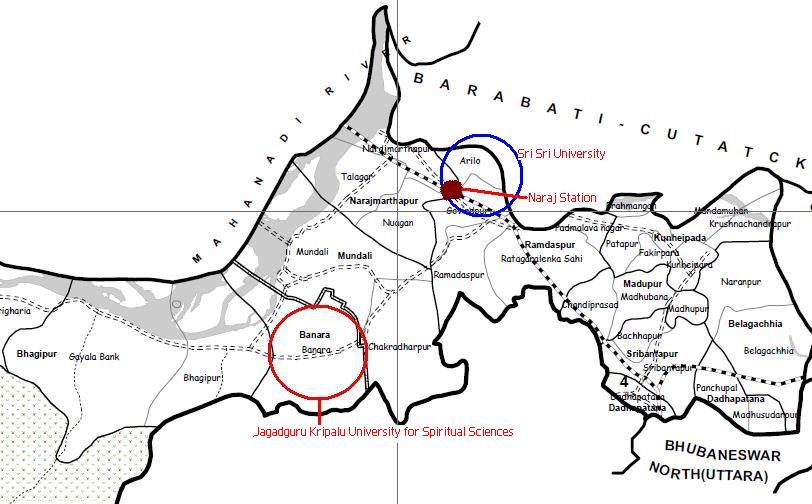
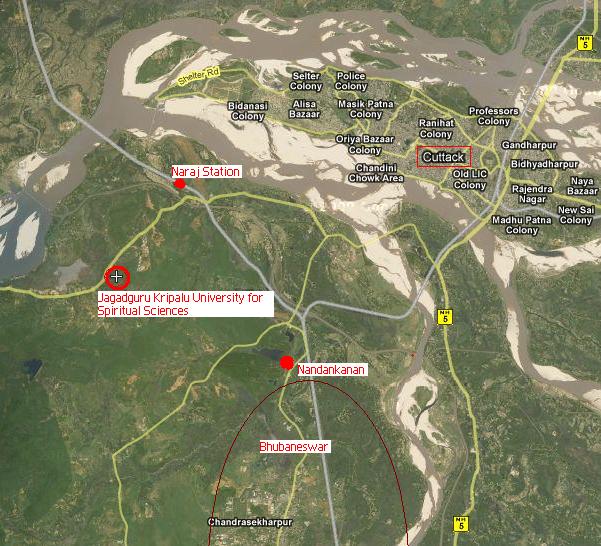
It now has its own web page. The web page has some nice drawings and overview of the university. We copy them here.
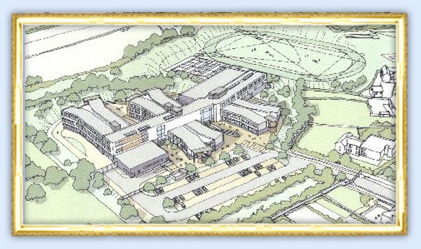
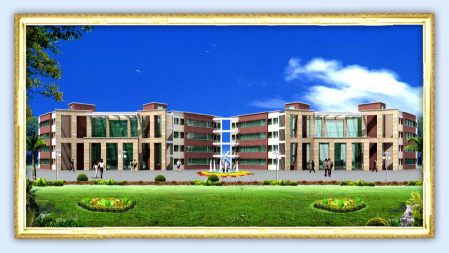
Introduction
A unique University that will train highly qualified Spiritual and Yog teachers for spreading the true and ancient science of "Yog" around the world will be built in the state of Orissa. The project will be a part of a spiritual community that will include a Gurukul, a Yog & Naturopathy Health Care Center, a Yogashram, a Charitable Hospital, and Organic cultivation farms.
The proposed university will be developed at Banki, near Cuttack, Orissa, in multiple stages. In the first stage, 110 acres of land has been finalised, and a Memorandum of Understanding (MoU) has been signed by the Trust and the Government of Orissa.
Objectives of the Proposed University


-
To Prepare Qualified teachers, who can then go to schools, colleges and industrial houses to teach the sciences of Spirituality, Yog and Mind management. At present, everyone realizes the imbalance in the education system, due to lack of spiritual education.
-
Introduction of moral education in all educational institutions. The creation of a qualified class of spiritual teachers will enable the introduction of spiritual education in society.
-
To give the spiritually-minded youth a chance to make a career in spirituality, by enabling them to earn a degree, and utilize it for teaching jobs.
-
To enable character building through higher education.
-
To reinforce ethics and morals so that the students may pass these on to the society at large.
-
For the upliftment of the underprivileged segments of society, free education and financial support will be given to 25 percent students from such segments of society.
-
The Proposed University will set a role model for the Universities of the country, in building the moral character of the people.
Courses Offered at the Proposed University
-
Bachelors and Masters in Yogic Sciences.
-
Bachelors and Masters in Vedic Sciences.
-
Teachers, Professors and Principals re-orientation programmes, with special emphasis on Morals and Ethics.
-
Bachelors and Masters in Naturopathy.
-
Bachelors and Masters in Bhakti Yog, in accordance with the philosophy of Jagadguru Shree Kripaluji Maharaj.
-
Research work – Doctorate – in Naturopathy, Vedic Sciences, Bhakti and Yogic Sciences.
-
One year diploma courses in all the above.
-
One month introductory courses in all the above.
-
One month Yog instructors course.
-
Karm-kand training courses for priests for temples in India and abroad.
-
Orientation programmes for Doctors in Yog Therapy.
Secular Courses- The students will also get an opportunity to do non-spiritual courses that offer the maximum job opportunities in the modern world, such as Information Technology and Business Management. This will enable them to get excellent careers in secular fields, if they so desire.
Related Projects:
Yoga Therapy and Naturopathy Healthcare Centre. It will attract outdoor patients from nearby towns and also neighboring villages. Also, indoor patients desirous of benefiting from yog therapy.
Gurukul. Will train children from childhood in the life of purity, charity, austerity, and spiritual knowledge.
Yogashram. Yoga shibirs will be conducted for the general public, for members, and for industrial houses. Such shibirs will be of 3 days duration, one week duration, two weeks duration and four weeks duration.
Old-age home. Devotionally minded people, who are leading a retired life, will be invited to come and stay in a spiritual environment. They will also be given an opportunity to lend voluntary seva in the above projects, and will form the manpower base for the project.
Hospital. The villagers of the nearby Banara village have demanded a hospital for them. Such a hospital, equipped with modern facilities will be built, to provide medical aid to everyone residing within 10 kilometers of the ashram.
June 19th, 2009
There is some progress in the IIIT front. Below is an excerpt from a Business Standard report. (In this regard, Orissa must insist that a new PPP based IIIT be established in Berhampur.)
… Nasscom has proposed that the IIITs be set up with an initial investment of Rs 30 crore, of which the government’s share should not exceed Rs 14.9 crore while the share of partnering companies should not be less than Rs 15.1 crore.
“A series of meetings have been held on the issue of finalising the PPP model for the IIITs. The final decision will be taken within a month’s time after which the institutes will be set up,” a senior HRD ministry official said.
Nasscom has also proposed that salary of faculty be linked to their output and the institutions have provisions of differential salary package.
As per the proposal, the IIITs will be autonomous degree awarding institutions. Each institute will have its own Board of Governors comprising 13 members, including one representative from the government.
The government will give a loan of Rs 100 crore to each institute with five years moratorium period and repayable within ten years time, Nasscom Vice-President Rajdeep Sehrawat said.
… As per the government’s plans, 20 new IIITs will be set up across the country in the Eleventh Plan period. Currently, there are four IIITs in the country. In north-eastern states and Jammu and Kashmir, where there are not enough industries, the government will bear the full establishment cost.
The IIIT, for which land will be provided by the states, will spread over 50 acres of area and have completely integrated campus with science and technology parks, he said.
Each institute will specialise on specific area of Information Technology. Each IIIT will be a centre of excellence in that domain. Nasscom has suggested that the institutes be set up in cities having modern amenities.
The IIITs will offer under-graduate, masters and PhD programmes. Each institute will have an intake capacity of about 1,000 students within a period of six to seven years of their functioning, he said.
June 19th, 2009
Update2: Pioneer reports the Orissa health minister saying that the state has been extremely co-operative on AIIMS and the allegations of Mr. Azad is baseless. The good news is that there has been some progress in the ground and
- Out of the 14 blocks of the AIIMS, the roof works of eight blocks have already been completed.
- An alternative road has already been constructed for the Sijua village and 90 per cent work has already been completed.
- Steps have been taken to remove the high-voltage transmission line.
Following is from Samaja:
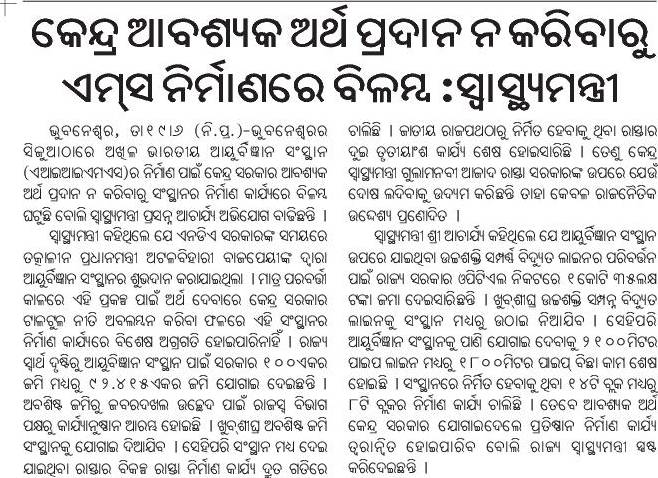
Update: TOI reports that Mr. Azad went to the AIIMS site and asked the project manager to work in three shifts and said that he will be monitoring the project every month. The first good news is that there is a project manager and some work is actually going on. 
The Central Cabinet minister of Health Mr. Ghulam Nabi Azad is visiting Orissa. His answers on the lack of progress with respect to AIIMS-like institute in Bhubaneswar is shocking. This institute foundation stone was laid by then PM Vajapayee prior to 2004 during the NDA government. Since then many reports have been made and tenders have been floated which we have been tracking here. And now Mr. Azad comes and blames the state government to hide the incompetency of the central Minitry of Health in making any progress. Note that the issue of tardy or zero progress on the AIIMS has been raised multiple times earlier, including many times in the parliament and someone even made a high court case in Bihar and this is the first time the state government is being partially blamed.
This is terrible. Mr. Azad should not play politics on such an importance issue and make sure tha the AIIMS-like institute is constructed as soon as posisble. Following are excerpts from a report in Business Standard which gives indication regarding the politics being played by Mr. Azad.
”I will review the progress in all the new AIIMS projects, including the one proposed to be constructed in Bhubanewar, to ensure these are ready in about three years. I will also speak to the construction agency,” Azad said.
Claiming that the steps taken by the state government for the ambitious Rs 820 crore project were slow and sluggish, Azad added that though the detailed project report for the Orissa AIIMS was ready proper land demarcation was yet to be completed.
The state should take quick steps to remove the high power transmission line at the site along with unauthorised structures and a small village relocated, the minister said.
On its part, the Centre was taking steps to bring momentum to the project, Azad informed adding he had spoken to Environment and Forests Minister Jairam Ramesh about the need for clearance to about 90 acres of the proposed AIIMS site here.
”Since Orissa badly needs an AIIMS, we are taking all steps to ensure that the project becomes operational at the earliest,” he said.To improve the health care facilities in Orissa, both the Centre and the state government must initiate steps for early completion of AIIMS here, Azad said.
Following is my email to the PMO and Mr. Azad on this topic.
Dear Esteemed Prime Minister and Health Minister:
Please do not play politics on the AIIMS-like institute in Bhubaneswar.
The foundation stone of this institute in Bhubaneswar was laid in 2003. In between 5 years of UPA government rule has passed in Delhi and nothing visible (beyond a boundary wall) has happened.
For the last 5 years, people of Orissa, representatives of Orissa (both MLAs, MPs), and Orissa CM have raised this issue and of no avail. In response to various parliament questions your ministers have always given one excuse or other for the delay.
And now for the first time Mr. Azad comes to Bhubaneswar and lays blame on the state government. (http://www.business-standard.com/india/news/centre-to-setnew-aiims-branches-in-three-years/64962/on ). This is playing politics on peoples lives and their health.
While the UPA government made a lot of progress on many fields (such as starting of classes on the new IITs, RTI, NREGS etc.) it has been grossly incompetent on the AIIMS issue.
To solve a problem, one must first admit that there is a problem. Please admit that your health ministry has been grossly incompetent and start over from there.
Please don’t play politics with people’s lives and their health. Please start the AIIMS-like institute in Bhubaneswar as soon as possible and to compensate for the delay as well as to take care of the backward areas of Orissa please immediately upgrade one of the exisiting medical college in the backward Western or Southern Orissa (one in Behampur or Burla) to the AIIMS level.
In West Bengal your are making a new AIIMS as well as upgrading Calcutta Medical College. In UP you will have a new AIIMS and are upgrading 3 medical colleges to AIIMS level.
In Mahasrashtra, Tamil Nadu, J&K and Andhra Pradesh you are upgrading two medical colleges to the AIIMS level. All these has been compiled from your web sites and PIBs and put together at https://www.orissalinks.com/archives/2111 .
Why not in Orissa? I sincerely hope that it is not because you had or have friendly governments in West Bengal, Mahasrashtra, Tamil Nadu, J&K and Andhra Pradesh and are eyeing UP and don’t really care about Orissa and its people?
Why do some other states get a new AIIMS as well as upgradation of multiple medical colleges to AIIMS level, and some get multiple upgradations to AIIMS level, while in Orissa no progress has happened for 5 years with respect to an announced AIIMS?
Sirs: Please pray tell us if this is not neglecting Orissa, what is?
Sirs: I again beg; Please do not play politics with people’s lives and health. Please expedite the establishment of AIIMS in Bhubaneswar and upgrade an exisiting medical college in the backward region of Orissa to the AIIMS level.
sincerely,
Chitta Baral
June 18th, 2009
Following is an excerpt from business standard
The new director of IIT-H, U B Desai, will encourage more interplay between various streams to give an edge to the students.
Speaking to Business Standard, he said IIT-H will encourage interdisciplinary courses to give an edge to the students. For example, it might set up a school of thermal sciences that would house electrical engineering and IT streams. There might also be a wing that would have a mix of biological sciences and information technology for a degree in bioinformatics.
Research will be a key focus area for IIT-H, Desai said, adding that about 35 M.Techs will be admitted this July. The institute also plans to admit about 10-15 PhDs. Last year, it admitted 11 research scholars. The research areas will span across computer science, chemical, electrical and mechanical engineering streams. “Faculty research will be promoted in a big way,” said Desai.
Eventually, it would have 10 departments and about 5,000 students and about 500 faculty at all levels to maintain a 1:10 faculty to student ratio. It would also gradually offer MSc courses in pure sciences. The total budget for the IIT-H complete with all facilities, faculty and infrastructure is put at Rs 1,200 crore, to be spent in phases including building a new campus in about 523 acre at Kandi.
IT-H, meanwhile, also plans to connect with the local community and invite local schools and colleges for various events at the institute to promote a scientific temperament among students. It also plans to work with universities and higher education institutes in the state in areas of mutual interest. “It is a challenging task to develop a greenfield institute,” said Desai, adding that best practices of other IITs would be replicated here.
June 17th, 2009
Update: A tathya.in article says the following:
With setting up of an All India Institute of Homeopathic Science(AIIHS) in Orissa, Minister Health & Family Welfare is hoping to make this system of medicine will be more popular among the people. Mr.Achrya revealed here on 26 June that the State Government has posed for this institution to the Centre. Recently we have sent a proposal to the Department of Ayurveda, Yoga and Naturopathy, Unani, Siddha and Homeopathy (AYUSH), revealed Mr.Achrya. AYUSH is setting up All India institutions of Ayurveda and Homeopathy in various parts of the country. Keeping this in view, Orissa has sent the proposal entailing an investment of Rs.60-70 crores for the institution, said the Minister.
Note that in January 2008 the cabinet took decision to establish an All India Institute of Aurveda in New Delhi. See also this report in Hindu and this report in thaiindian.
Dharitri below mentions that it is one of the 5 such institutions that have been picked. On the other hand the site http://www.indianmedicine.nic.in/national-institute.asp lists the existing national institutes under the Department of AYUSH (Ayurveda, Yoga, Naturopathy, Unani, Siddha and Homeopathy). They are:
- NATIONAL INSTITUTE OF AYURVEDA (NIA) JAIPUR.
- NATIONAL INSTITUTE OF SIDDHA (NIS), CHENNAI
- NATIONAL INSTITUTE OF HOMOEOPATHY, KOLKATA
- NATIONAL INSTITUTE OF NATUROPATHY, PUNE
- NATIONAL INSTITUTE OF UNANI MEDICINE, BANGALORE
- INSTITUTE OF POST GRADUATE TEACHING & RESEARCH IN AYURVEDA, JAMNAGAR (GUJARAT)
- RASHTRIYA AYURVED VIDYAPEETH, NEW DELHI
- Morarji Desai National Institute of Yoga, New Delhi
Following is the report from Dharitri.
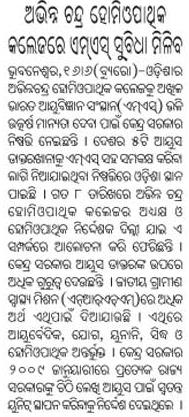
June 17th, 2009
Following is an excerpt from a report in Pioneer.
While one proposal has come from the State Planning and Coordination Department (SPCD), another was offered by the Defence Department. Though these proposals are in the preliminary state as observed by ADM Sribatsa Jena, …
According to sources, the State Planning and Coordination Department has asked the district administration to identify adequate land for setting up the medical college. The district administration also earmarked a land for the purpose at Remuna.
“We have intimated SPCD Secretary Bijay Arora regarding the land position and we have a patch of land adequate enough for the purpose at Remuna. The land was earlier earmarked for setting up a hospital by some private parties, who later abandoned their ideas,” said Jena.
Meanwhile, another inquiry has come from the Defence Department, asking the district administration for feasibility of setting up a medical college in line of the Armed Forces Medical College.
“We received intimation from the Defence headquarters before the general election and we are working towards it. The district Collector will shortly hold a meeting in this regard with the directors of the PXE and ITR,” said Jena claiming the administration is keen to convert the planning into reality.
Notably, the Defence (Army) has begun initiations to establish a training school at Amarda, acquiring land including Rasgobindapur in Mayurbhanj district, besides reviving the British time unused airstrip at the place.
June 16th, 2009
Update 2: Tathya reports that the site mentioned below is not chosen by MHRD. They pick a site near Sunabeda.
Update1: Tathya.in has a report comparing the two sites that are in contention.
Following is from Dharitri.
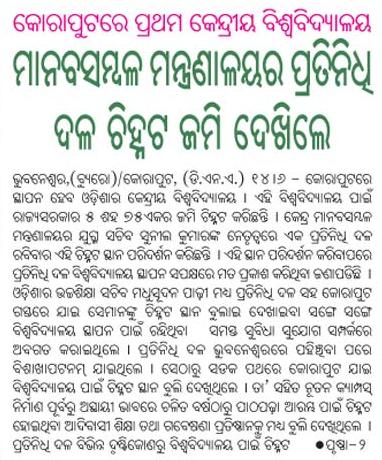


June 15th, 2009
Following is an excerpt from a report in Times of India.
About 124 students of rural schools were felicitated by chief minister Naveen Patnaik on Saturday for their brilliant performance at the National Math Olympiad.
Shradha Ranjan Grahacharya, a Class IX student at Kanakpur in Jagatsighpur district, wants to be a scientist and do research in her favourite subject, algebra. Although mathematics as always been her favourite, she began to take greater interest in the field after she was selected for the Rural Mathematics Olympiad (RMO) in 2006 when she was in Class VI.
"After I was picked for the RMO camp, I started liking the subject even more. At the camp, teachers taught us some easy methods to solving difficult mathematical problems," said Shradha, who stood first in the Junior Mathematics Olympiad, 2008.
According to IMA director Swadhinananda Pattanaik, there is a lack of interest in mathematics among parents and teachers, especially in government schools in villages. Hence, the IMA has decided to make teaching of mathematics an interesting and fun-filled activity.
"In most classrooms, there is little opportunity to understand maths beyond the level of solving equations. Typically, students just memorize mathematical facts without actually understanding the subject," he said.
Encouraging the young mathematicians, chief minister Naveen Patnaik said, "The IMA’s efforts are commendable, especially the special programmes to prepare students for premier institutes like IIT and NISER. This is the only institute of its kind in the country. I hope it will spread its wings globally very soon".
Besides the 124 young students, 33 senior students who performed well in the Regional and National Mathematics Olympiad were also felicitated. IMA is also conducting summer camps for undergraduate and post-graduate students.
June 15th, 2009
Following is from http://timesofindia.indiatimes.com/Columnists/SA-Aiyar-An-open-letter-to-Kapil-Sibal/articleshow/4653435.cms.
| SWAMINOMICS |
Back to school: An open letter to Kapil Sibal
14 Jun 2009, 0031 hrs IST, Swaminathan S Anklesaria Aiyar
|
|
|
Dear Kapil Sibal,
… for truly inclusive growth we must focus on improving basic education for the poor and historically disadvantaged classes. Poor people send their kids to government schools, but hardly any teaching takes place there, and the teachers are protected from disciplinary action by powerful trade unions. No chief minister dares antagonize these unions. Richer students supplement schooling with private tuitions, but this is unaffordable by poor students, who end up functionally illiterate after years of schooling. Lakhs of crores spent on education are wasted.
School vouchers can be one way forward. Parents can get outright grants per child in the form of school vouchers, which are redeemable only for expenses in a government or private school. Vouchers will empower poor people through choice in schools, just as democracy empowers them through choice in politics. Competition with private schools will improve government schools, just as competition from private airlines and banks have improved service in government airlines and banks.
But teachers’ unions hate competition or accountability, and oppose school vouchers. They also point out that the results of school vouchers in western countries have been mixed. In some states in the US, voucher students perform no better than those in government schools. In Sweden, on the other hand, voucher students fare distinctly better.
But in those countries, government teachers actually teach. This, alas, is not the case in India. And so desperate urban slum families are pulling their children out of free government schools and sending them to private schools, at great financial sacrifice. These private slum schools are hardly of high quality, yet are better than government schools having highly qualified teachers but little teaching. The very fact that slum-dwellers are sending kids to private schools in large numbers is the best evidence that private schools are better, whatever may be the experience in the US or Europe.
In Delhi, the Centre for Civil Society has started a small project offering school vouchers worth Rs 3,600 per year to 408 children. An independent evaluation shows that voucher children perform better in standardized tests than comparable children in neighbouring government schools; that parents find the teaching and infrastructure better in private voucher schools than government schools; and that over half the poor beneficiaries will be forced to send their children back to government school if the vouchers are withdrawn. This shows that vouchers are badly needed by the poor, and yield better results too.
The Delhi scheme is tiny. Some chief ministers have sought other ways to try and scale up vouchers. In Rajasthan, the former BJP government sought to persuade government teachers to start private schools, for which students would be given vouchers. Unsurprisingly, this failed to find many takers.
So, Kapil Sibal, let me propose an alternative. You should launch a pilot project, making funding available to states who are interested, and scale up after removing the inevitable glitches. The project should offer school vouchers to urban children of disadvantaged minorities — Dalits, tribals and Muslims. Only urban areas have multiple schools within walking distance of every locality, and that is a necessary condition for real choice.
Teachers’ unions will oppose this idea too. But their opposition will be muted since the benefits are limited to a small, historically disadvantaged section of the population. Besides, the idea will be supported by vote-banks of Dalits, tribals and Muslims, all of whom are wooed by politicians. Chief ministers will find it worthwhile to take on trade unions only if they are compensated by support from substantial vote banks.
In the Delhi scheme, activists spread information about vouchers in areas with 12 lakh citizens, of whom 1.2 lakh applied for vouchers. The vouchers were awarded through a draw of lots to a lucky few. Although only 408 children benefited, the project enthused over a lakh households, a number high enough to qualify as a vote-bank, and so interest politicians.
Teachers will see this as the thin end of the wedge, and launch agitations. One form of compromise could be to offer vouchers at least to girls from Dalit, tribal and Muslim families. Even the most cynical unions may feel ashamed of denying benefits to the most oppressed gender among the most oppressed classes.
Kapil Sibal, your new government is committed to affirmative action for the historically disadvantaged. This can be an excellent launching pad for school vouchers. Do not waste the opportunity.
I have written about this approach in the past. I think its time has come. An interesting fact not mentioned in the above article is that in many private schools teachers are paid less but the students do much better. A good example is the Sarasawti Sishu Mandirs. (Lets us ignore the religious organization behind those schools.) So pumping money to primary education is by itself not enough; nor is the the "Right to education act." What is needed is the "Right to Choice of Education."
I slightly disagree with the suggestion that this has to start in the urban areas. i think pilots should also be done in rural areas as the fact that government will be providing vouchers might actually encourage private organizations to open schools in those areas. With PMGSY the private schools in rural areas may even provide transportation.
June 14th, 2009
The following outline is from http://dtfnet.wordpress.com/2009/04/18/yashpal-committee-report/. (The full interim report is also at http://web1.du.ac.in/du/yashpal–report.pdf and http://www.jnu.ac.in/Yash_Pal_Committee.pdf)
Report of ‘The Committee to Advise on Renovation and Rejuvenation of Higher Education in India’
Pages: 1 2 3
Renovation and Rejuvenation of Universities
(An Interim Report)
1 March 2009
Table of Contents
Preamble
1. Executive Summary
2. The Idea of University
3. Problems of the Indian Higher Education Sector
3.1 Undermining undergraduate education
3.2 Low pedagogic quality
3.3 Distances: Within and outside
3.4 Isolation of the Indian Institutes of Technology
3.5 Divide between research bodies and universities
3.6 University as an inclusive space
3.7 State universities and affiliated colleges
3.8 Poor governance of universities
3.9 Interference in university functioning
3.10 Interference and loss of autonomy
3.11 Subversion of the principle of autonomy
3.12 Growth of private-commercial providers
3.13 Affordability problems
3.14 Other apprehensions about private universities
3.15 Unhealthy growth in the number of deemed universities
3.16 Multiplicity of regulatory systems
4. Recovering the Idea of University
4.1 Theory and practice
4.2 The challenge of local knowledge
4.3 Curriculum issues and syllabus-making
4.4 Work experience as an aspect of learning
4.5 Rehabilitating professional education in the university
4.6 Teacher education
4.7 Few premises on institutional autonomy of universities
5. Reforming the Regulatory System
5.1 Objectives of the commission for higher education
5.2 Restructuring Universities
6. Recommendations
Annex A
June 14th, 2009
Following is excerpted from a report in expressbuzz.com.
- This year 5,552 had applied for MCA courses in the JEE and 4,946 are on the merit list. Last year 6,422 candidates were on the chart.
- Last year, there were about 2,900 seats in both the government and private institutes that offered MCA programmes. This time around, the number is set to remain same.
- MBA: Last time there were 10,957 candidates on the merit list and this time it has dropped marginally to 10,652. The number of seats is likely to rise though – from about 3,200 in 2008 to 3,500.
- Pharmacy: In 2005, about 700 had taken admission but last year just 180 turned up. This time, 9,788 students are on the merit list but colleges are unsure.
- Engineering: There are at least 57,352 candidates put on the rank list of JEE even as the seat strength of colleges is on the rise. From about 20,650 seats in 63 colleges in 2008, it is expected to rise by another 6,500.“We expect 15 more institutes getting affiliation by the time counselling starts which will add about 3,600 seats. Besides, some existing institutes have sought a raise in seat strength too,’’
- Counselling by JEE Committee is likely to start from July 12.
June 13th, 2009
Following are some excerpts from that article.
… The university hospital, which will be built near the Puri-Konark Marine Drive, will be distinctive with its world-class facilities and infrastructure. The hospital will place equal emphasis on patient care, research, and teaching. It will be staffed by renowned doctors from India and abroad. …
Commending this initiative, eminent Indian cardiologist Dr KP Misra, said, "The hospital will serve as a regional hub for critical specialties including cardiology and diabetology. As a teaching and research hospital, it will attract leading researchers and specialists in medical science from around the globe. The university’s research agenda will prioritise public health solutions that address the most prevalent medical issues in the region."
On the occasion of the launch of the Vedanta University hospital project, a national seminar on ‘Optimum Medical Education and Ethics in Clinical Practice’ was organised at Bhubaneswar. The national conference was addressed by leaders in medical science of international repute, including Padma Vibhushan Professor MS Valiathan and Padma Bhushan Professor NK Ganguly.
The conceptual planning and design of the hospital has been prepared by the leading US-based hospital design firm Perkins + Will, which has previously designed state-of-the-art teaching and research hospitals at institutions such as Johns Hopkins University and the University of California at Los Angeles.
"The 500-bed multi-specialty hospital will commence during the first phase of the University. Orders for construction have already been placed with Larsen & Toubro Limited," added Sanjeev Anand Zutshi, Director of the project. The university has already initiated research programmes with local relevance. Dr Dipika Mohanty, a recipient of the Biju Patnaik award for Excellence in Science and Technology, has begun a Vedanta University-sponsored research project on interventions that can address the disproportionate prevalence of anemia in infants and children of Orissa.
The Vedanta University Hospital is a cornerstone of the institution’s larger commitment to serving public needs. Students and faculty across disciplines will be encouraged to engage with local challenges, search for solutions that contribute to the development of Orissa, and pursue research priorities that have real impact on the lives of people. In addition to initiatives in medicine, the first phase of the University will include schools of education, arts & sciences, engineering, management, and nursing. The hospital and initial academic programs will begin in 2011.
June 12th, 2009
Following is from http://www.cse.iitd.ernet.in/~jalote/misc/phd_surveyIITK-D-B.pdf linked from Prof. Pankaj Jalote’s home page at IIT Delhi.
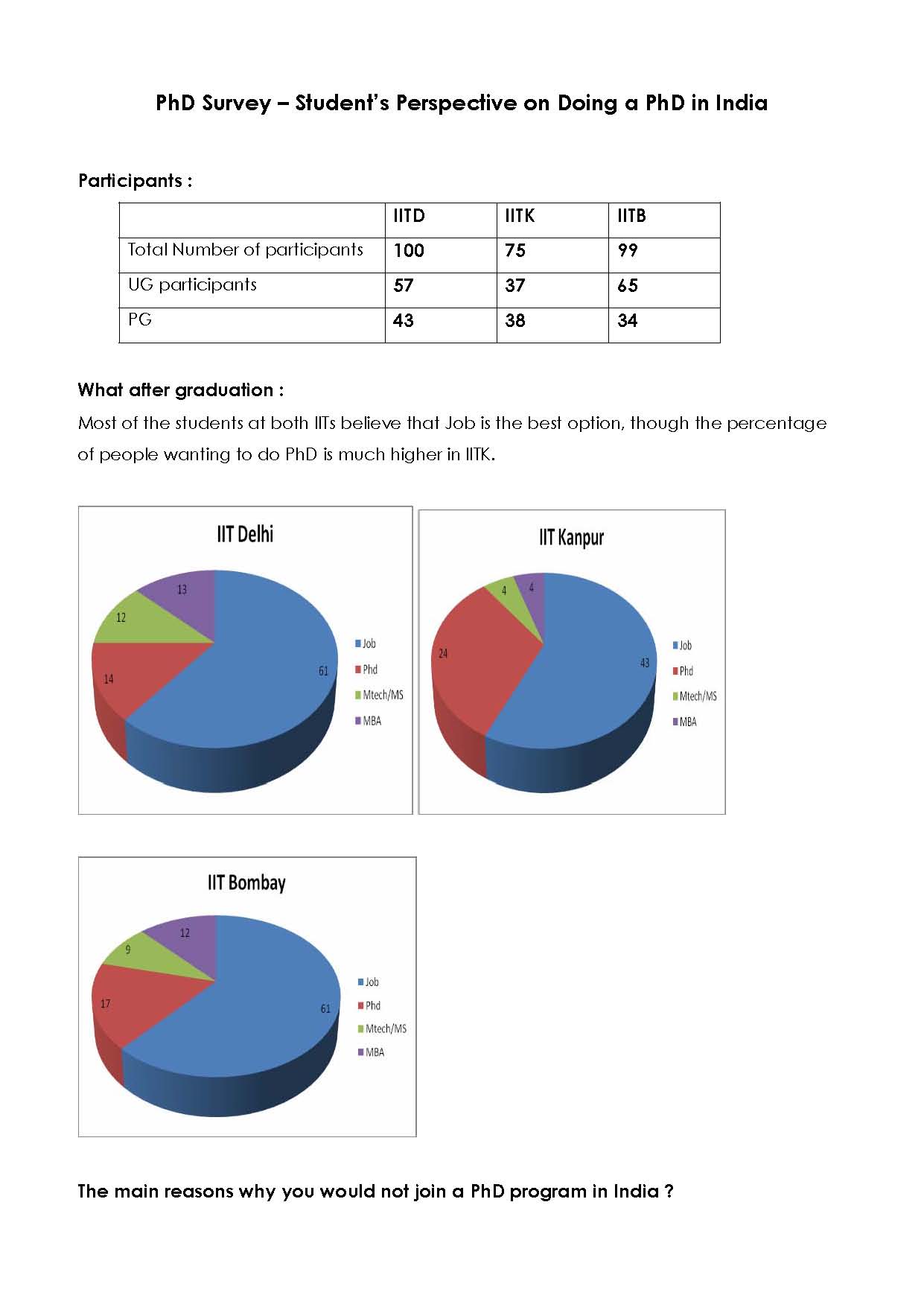
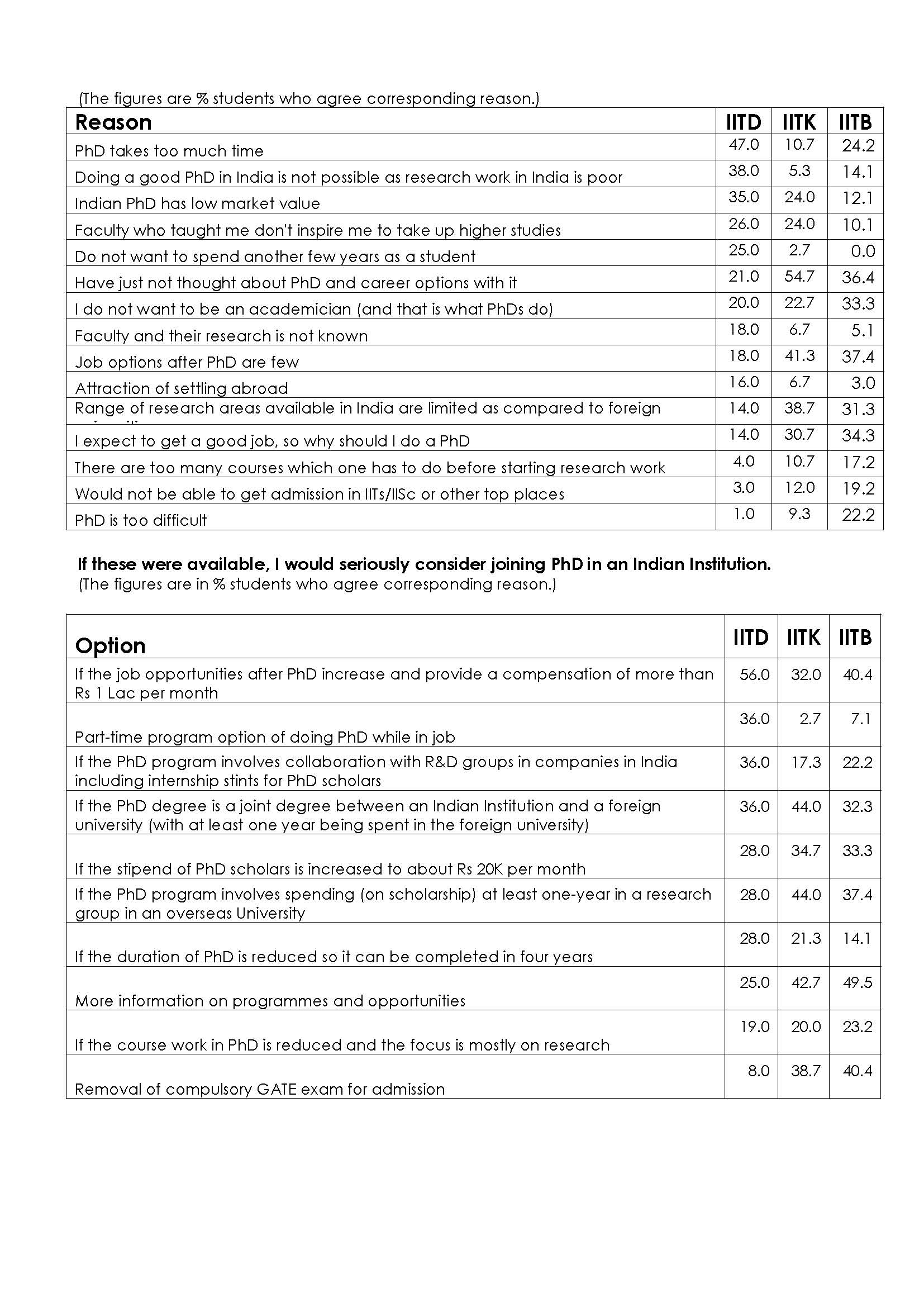
Based on the above survey, a simple way to build a private top quality university in India is to pay more than twice the amount that is paid to faculty at IITs/IISERs/NISER (starting with 100K/month to assistant professors) and to pay Rs 40K/month to Ph.D students. These Ph.D students may be asked to help in teaching as teaching assistants in US universities do. That way many top undergraduates will pursue Ph.D in this institute and by paying more than twice to the faculty the institution can attract top faculty. This could be a a data point for Vedanta University.
June 12th, 2009
Update on 27th April 2011: The Central University location has been changed to Bander Sindri near Ajmer and only 80 kms from Jaipur. The Innovation University (previsouly referred to as National University) aiming for world class is now pushed for Jaipur. [Times of India]
The panel set up by the CM of Rajsthan has picked the following places to recommend to the central government for the various national institutes and universities coming up in Rajasthan. (From a Times of India report and another Times of India report)
- IIT : Jodhpur
- IIM: Udaipur
- National University aiming for world-class: Ajmer
- Central university: Bikaner.
The committee also recommended:
- a "futuristic" heritage conservation and museology centre in Jaipur
- an institute of Food Technology in Hadoti region of Kota
Currently the following national institutions exisit or are being made in the following places in Rajasthan:
- NIT: Jaipur
- LNMIT (private but top-notch): Jaipur
- National law School: Jodhpur
- AIIMS-like institution (being made): Jodhpur
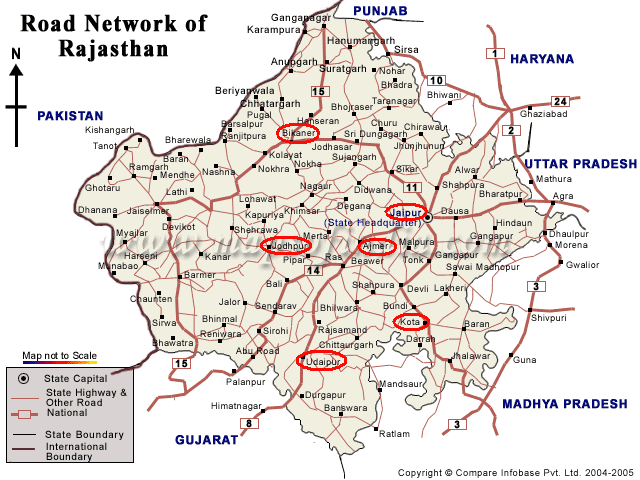
The institutions are nicely distributed between various cities of Rajsthan, although people of Jaipur and Kota are not happy. The population of these locations are:
- Jaipur (World Gazetteer 2009): 3.1 million (has inetrnational air connectivity)
- Jodhpur (World Gazetteer 2009): 988K – (332 kms from Jaipur; has air connectivity)
- Udaipur (World Gazetteer 2009): 457K – (400 kms from Jaipur; has air connectivity)
- Ajmer (World Gazetteer 2009): 604.7K – (131 kms from Jaipur)
- Bikaner (World Gazetteer 2009): 624.6K – (321 kms from Jaipur)
- Kota (World Gazetteer 2009): 823 K (242 kms from Jaipur)
In contrast in Orissa the distribution of national institutions are more Bhubaneswar centric. Following is the status:
- IIT: Bhubaneswar
- NISER: Bhubaneswar
- AIIMS-like (being made) : Bhubaneswar
- National Law University: Cuttack (part of Bhubaneswar metroplex)
- IIIT (state-funded) : Bhubaneswar
- National University aiming to be world class: Bhubaneswar
- Vedanta University (private): Puri
- NIT: Rourkela
- Central University: Koraput
- IIIT (centrally funded): state wants it in Berhampur; center has identified as Bhubaneswar
Unfortunately, one of the reason given behind the above selection is the lack of connectivity and the size of places. Following is some information on that.
- Bhubaneswar (World Gazetteer 2009): 1.67 million (has airport but no inetrnational connectivity)
- Rourkela (World Gazetteer 2009): 551 K (no air connections) – 334 kms from Bhubaneswar
- Berhampur (World Gazetteer 2009): 403 K (no air connections) – 160 kms from Bhubaneswar
- Koraput-Jeypore-Sunabeda: 200K+ (no air connections) – 499 kms from bhubaneswar
- Puri (World Gazetteer 2009): 185K – 60 kms from Bhubaneswar
- Sambalpur (World Gazetteer 2009): 258 K (no air connections) – 321 kms from Bhubaneswar
- Jharsuguda-Belpahar-Brajarajnagar: 200 K (no air connections) – 374 kms from Bhubaneswar; 50 kms from Sambalpur
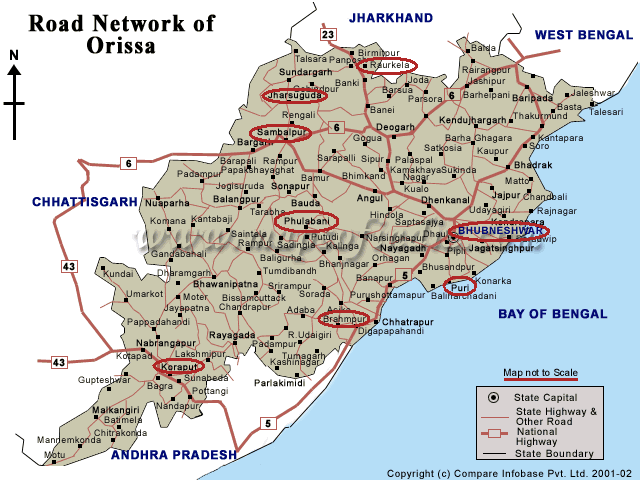
For the future, following are some of the steps that Orissa government needs to urgently take regarding developing more larger urban areas and having the national institutions more evenly distributed:
- Make sure the centrally funded IIIT is established in Berhampur
- Establish functioing airports in Jharsuguda, Rourkela and Koraput at the earliest
- Push for international flights to Bhubaneswar
- Push for upgradation of UCE Burla (Sambalpur area) to an IIEST (Indian Institute of Engineering Science & Technology)
- Push for the establishment of a branch of IGNTU (Indira Gandhi National Tribal University) in Phulbani
- Push for the establishment of IIM outside of the Bhubaneswar area
- Push for the establishment of a centrally funded KBK Inst of Engineering and Technology (along the lines of SLIET and ABAGKIET) in Kalahandi or Balangir.
- Push for upgrading another medical college (Berhampur or Sambalpur) to AIIMS level.
- Push for establishing NID in a location outside of Bhubaneswar
- Push for establishing NIPER in a location outside of Bhubaneswar
- Push for a BITS Pilani campus in a location outside of Bhubaneswar
June 12th, 2009
Next Posts
Previous Posts















